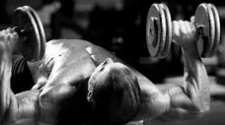Bench Press Variations

It is critical to target all muscle fibers from all angles for optimal growth!
Without a doubt, the bench press is the most popular of all barbell exercises. It is often referred to as the king of the upper-body exercises-and deservedly so. The bench
press has more potential positive impact on upper-body size and strength than any other exercise known.
Hard work on the bench is the best way to develop impressive size and strength in the pectorals, delts and triceps. In the quest for maximal and symmetrical development of
those bodyparts, however, many weight trainers have to add other exercises, such as inclines, declines, dips, etc.
What many of them overlook is that there are variations of the bench press that are convenient, cost effective and as equally result-producing. By properly identifying and
integrating these variations into your training arsenal, you can achieve your goals without all the needless exercise additions.
The first way to alter the effects of the bench is to vary grip width. By doing this, you will hit your benching muscles from different angles, resulting in more complete
development. Generally, weight trainers use a grip slightly wider than shoulder-width, which is about the best compromise for hitting the chest, delts and triceps.
If you desire more pec, moving your grip out will do the trick. Be careful to work into wider grips gradually, as you may lack shoulder and pec flexibility, which could result
in injury. Also, when going wider, warm up thoroughly, and never use an extremely wide collar-to-collar grip on an Olympic bar, as it is very strenuous on the joints.
On the other side of the coin, narrowing your grip will emphasize your triceps more and lessen the involvement of your pecs. Many trainees use a very narrow grip-with their
hands touching in the middle of the bar. This extremely narrow grip is less productive because it creates extra stress on the wrists to support and balance the barbell for
the set. A grip within an inch or two of shoulder-width is more productive and will involve your triceps to a high degree. You will also be able to use a heavier weight with
greater safety and comfort because of better control of the bar.
Besides varying your grip to attack and stress different muscle groups, varying where the bar comes in contact with the chest can be an effective way to new gains. For example,
by benching higher on the chest toward the neck and shoulders, you can really hit the upper pec. This way you're not forced to rely on the incline bench for upper-pec development.
As with grip-width changes, work into these gradually and warm up thoroughly. If you lower the bar too fast or too deep to the neck, you could pull something. Also, since you're
taking the bar to the neck, you could pull something or get stuck in the dangerous bottom position. Use a spotter when performing these bench presses to the neck.
By touching the bar lower on the chest-away from the neck and shoulders you can emphasize the lower- and mid-pec area. This will give you almost the same development as declines,
but without the need for a decline bench.
Another way to vary the emphasis of the bench press is by working with elbow position. If you keep your elbows at right angles to your body during the press, you shift more
emphasis to the pecs. By keeping the elbows in toward the body, the triceps are stressed. By combining a wider grip with elbows at right angles to your body, you can really
emphasize the pecs. A narrow grip with the elbows in close will hit the triceps hard.
The final way to vary your benches is with partial presses-decreasing the range of motion. Pressing the bar only two-thirds of the way up from your chest will keep tension on the
pecs. Throw in a wide grip and elbows at right angles, and you have an excellent pec exercise that still allows you to use a good amount of weight.
The opposite variation-taking close-grip benches only two- thirds of the way down-will really overload the triceps. Keep the elbows close to the body, and you've got a great
arm-builder.
Let's take a look at some specific applications
Bodybuilder needing more upper pec. The solution is wide-grip benches to the neck with elbows flared at right angles to the body. You could also work in partial presses two-thirds of the way up from your chest.Powerlifter needing more triceps power. The solution is the close-grip bench press with elbows close to the torso. Partial close-grip benches can also be used for variety and overload (more weight is used on partials).
Average lifter looking for more complete development and power. The solution is to do a mixture of wide-grip, elbows-out benches to mid-chest for overall pec development and close-grip, elbows-in benches for triceps.
You ran see how combining grip width, elbow position, point-of-chest contact and range of motion can radically change the effects of the common bench press. These variation will enable you to tailor your benches to hit any area that you feel needs more work, and you won't need a lot of different types of benches or other costly equipment. This can be particularly valuable to home-gym lifters who lack the necessary space or cash to outfit a complete gym yet need variety for total development.